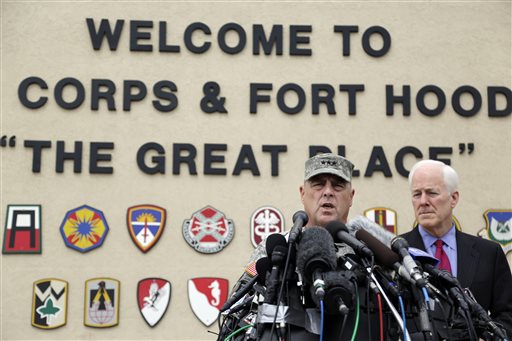
DALLAS (AP) — After three mass shootings at military bases in the U.S. over the last five years, security experts say the sad truth is that there is probably no practical way of preventing members of the armed forces or civilian employees from carrying guns onto big installations like Fort Hood.
The kind of searches that would have prevented Army Spc. Ivan A. Lopez from driving onto Fort Hood with a pistol in his car and killing three fellow soldiers would paralyze access to a major post and create huge traffic jams among the tens of thousands of workers commuting to and from their jobs, officials and experts said.
“Trying to secure a base from guns is a very, very difficult proposition at best — probably impossible,” said Robert Taylor, who is head of the University of Texas-Dallas public affairs program and has been a security consultant for the Justice Department and police forces.
“You could do spot checks. You could have people walk through metal detectors,” Taylor said. But searching so many people would create big practical difficulties, he said.
Dan Corbin, mayor of neighboring Killeen, said base workers would have to leave for their jobs four hours early just to get through the base’s checkpoints if searches were instituted.
The security problem on large bases stems from their dual role as military installations and huge workplaces.
Fort Hood, the nation’s largest Army post, covers 340 square miles. More than 40,000 soldiers live on the post, and more than 80,000 military and civilian employees and contractors come there from surrounding communities every day to work at offices, equipment facilities, training sites and businesses.
Though the post is ringed by fences with guard stations, it otherwise looks like a medium-size city with neighborhoods of single-family houses, schools, stores and restaurants.
Security was beefed up after the base’s first mass shooting, in 2009, in which Maj. Nidal Hasan, an Army psychiatrist, killed 13 people. Security measures were reviewed again last September after Aaron Alexis, a mentally disturbed civilian contractor, shot 12 people to death at the Washington Navy Yard.
In both cases, the killers had credentials to enter the military installations and brought in guns.
After the 2009 attack, Fort Hood posted more guards, armed them with long-barreled weapons and added training on insider attacks. The military also stepped up efforts to identify troubled service members and joined an FBI intelligence-sharing program.
But authorities did not require searches of all people and vehicles entering the post.
While visitors are required to check in at a welcome center outside the fence line to get a pass or an escort, soldiers who are stationed there and authorized base employees are usually waved through checkpoints if they have Department of Defense credentials and a car sticker, though some are subjected to spot checks.
Even with quick access for those with credentials, long lines of cars can form at the gates in the morning.
“It would not be realistic to do a pat-down on every employee and soldier for a weapon on a daily basis,” said Lt. Gen. Mark Milley, Fort Hood’s senior officer.
After driving onto the post, Lopez shot his first victims at the medical battalion building, then moved on to a building across the street. He shot himself in the head after being confronted by a military police officer.
Defense Secretary Chuck Hagel said authorities will review security procedures at Fort Hood again, in light of the latest rampage.
“What motivated this person to do this? Where was the gap, why did we have a gap, why did it happen?” he told reporters in Honolulu.
The investigation will also focus on Lopez’s mental condition and the treatment he received.
Lopez had received psychiatric care for depression and had reported that he might be suffering from post-traumatic stress disorder, officials said. He served as a truck driver in Iraq for four months in 2011. Officials said he was not in combat.
Lt. Col. Chris Jenks, an Iraq War veteran who now teaches law at Southern Methodist University in Dallas, said the military has not resolved how to assess the emotional stability of its soldiers.
“What do you do with a Lopez? If you have PTSD, do you need to leave the military? That seems akin to punishing the victim and shifts the problem to Veterans Affairs and society,” Lopez said. “But at a certain point allowing them to remain in the military also seems problematic.”

